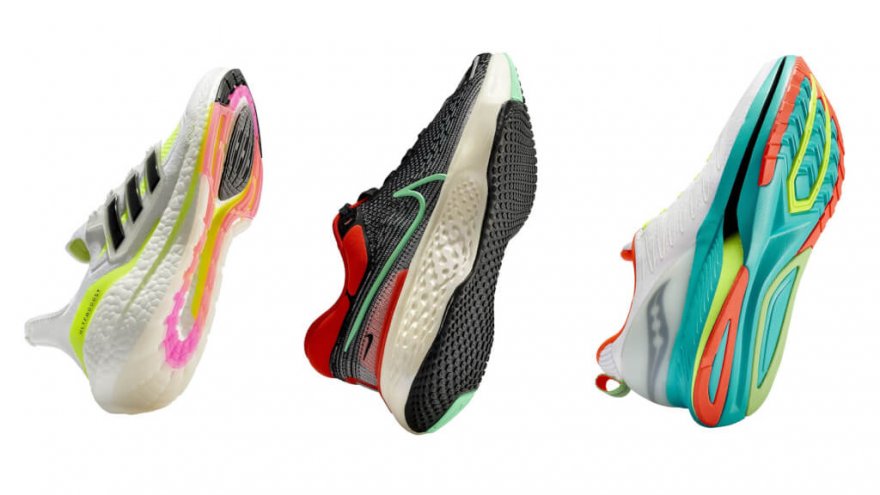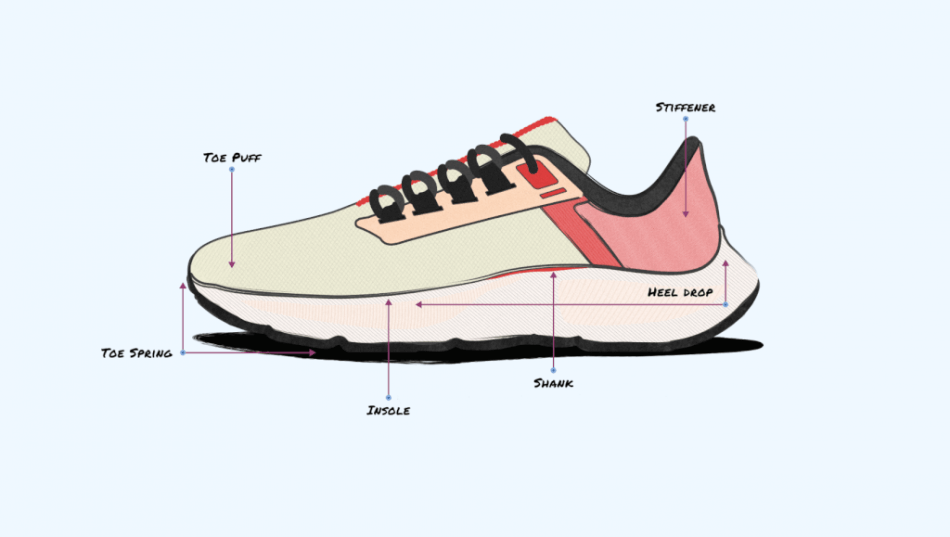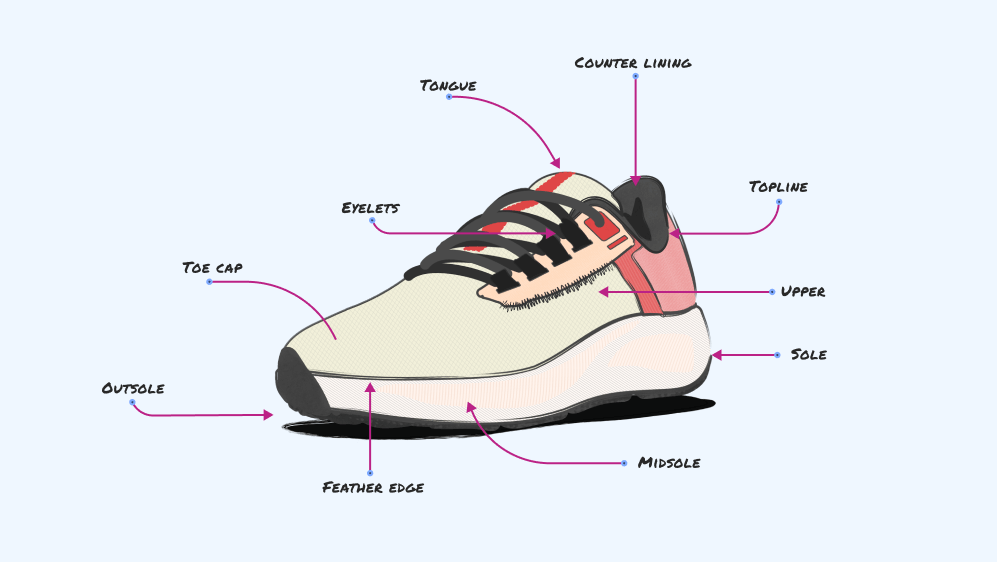Anatomy Of A Shoe: Quick Guide On The Parts Of A Shoe

Shoes are something we mostly take for granted. Whether running, walking, lifting weights, or just going about your day-to-day business, it is easy to slip on a pair of sneaks without even thinking twice about it.
If you give it some thought, though, knowing even a small amount about the anatomy of a shoe can be beneficial when shopping for your next pair. Read on to learn more!
Fun Fact: There are over 30 different parts of a shoe.

What are the Main Parts of a Shoe?
Some people talk about a shoe as having three primary parts. If you are looking at it in the most simple terms, the three parts are the upper, the midsole, and the tread or outsole.
However, if you are breaking it down further, you will find it is more complicated than that.
We like to focus on the seven primary parts of a shoe when testing and reviewing the best running shoes;
- Upper: Starting from the very top is the upper of the shoe. The upper is of various materials, and it keeps the foot protected.
- Tongue: The tongue sits beneath the laces and is a separate strip on the upper that works to protect your feet from the laces.
- Heel Counter: This is the structure around the outside of the heel. It helps to cradle your foot into place.
- Last: Often called the heart of the shoe, the last is the three-dimensional form that the shoe is created around.
- Toe Box: The front portion of the shoe that houses your toes, the toe box needs to be the perfect size for your feet and how they move. Too narrow of a toe box can result in blisters or bruised toes. Believe it or not, but too roomy of a toe box can have the same effect.
- Midsole: Directly above the outsole is the midsole. This portion of your shoe provides the cushion your feet need to absorb impact when running or walking. It can also provide control if you pronate.
- Outsole: The threaded, bottom rubber part of your shoe, the outsole helps you have traction when you are running.
What is the Middle Part of the Shoe?
Referred to as the insole or the footbed, the middle portion of the shoe is significant because it provides the most cushion or support in the shoe.
The insole can be made of a variety of different materials. Typically designed to provide a cushion and to absorb the shock of each step, the insole has a crucial job to do.
Pro Tip: Focus most of your attention on finding a shoe with the ideal insole for your foot. Preventing injury and performing at your best can’t happen without a properly fitted insole.
Parts Of A Shoe: A Comprehensive List
Backstay: The area of a heel counter running vertically down the center.
Breast: The forward-facing part of the heel that sits under the arch of the sole.
Counter: A piece of material forms the back of a shoe to give support and stiffen the fabric around the heel. The counter helps strengthen the rear of the shoe.
Collar: The opening of the shoe where you insert your foot is called the collar. It’s is often padded for extra comfort.
Eyestay: The lace stay is also the section of a shoe where the laces are threaded.
Eyelet: The holes through which laces are passed are often reinforced with metal or plastic. The average number of eyelets in shoes ranges from 1-9.
Feather edge: Sometimes referred to as just the ‘feather, this part is where the upper edge’s meet the sole.
Heel: The heel is the back of the shoe between the heel of the foot and the ankle.
Heel seat: The top of the heel that touches the upper. It’s often shaped to match the form of the upper.
Quarter: The rear and sides of the upper cover the heel, which is behind the vamp.
Sole: This is the fundamental part of the shoe that sits below the foot. As opposed to the upper. The upper and sole make up the whole of the shoe.
The sole is usually constructed of a layer of materials.
- Outsole: The bottom of the shoe that is in contact with the ground. As with all parts of the shoe, outsoles are made from a variety of materials. The properties the outsole need are grip, durability, and water resistance.
- Midsole: A mid-sole can be found on some shoes but is not always a requirement. The midsole is a layer between the insole and the outsole. They are often seen in athletic styles to help offer extra suspension.
- Insole: This is inside the shoe designed to support the arch of the foot.
Throat: The front of the vamp next to the toe cap.
Toe cap: Shoes may have a toe cap in the front upper of the shoe. Toe caps can take various forms and can be both decorative and protective.
Toe box: The area of a shoe in which the toes reside.
Tongue: The part of the shoe that makes contact with the top of your foot. On a lace-up shoe, it resides underneath the eye stay and laces.
Top Piece: The part of the heel that comes in contact with the ground, more commonly seen in high heels and men’s formal styles. Made of a durable material that helps maintain friction with the ground.
Topline: The top edge of the upper.
Upper: The whole part of the shoe that covers the foot.
Vamp: The section of upper that covers the front of the foot and goes as far as the back.
Waist: The arch and in-step of the foot
Welt: A strip of material that sits between the upper and sole to ensure a secure bond.
Shoelaces – The fabric laces the wearer uses to tighten the shoe when placed on the foot

What Are Shoes Made Of?
The seven most common materials that shoes are made of ;
- Leather
- Canvas
- Textiles – Cotton, Nylon, Wool, Polyester
- Natural Rubber
- Synthetics
- Foam
- Denim
Dress shoes are primarily made out of leather, with some rubber and textiles being used in the sole and binding pieces of the shoe.
As for running shoes, most mainstream shoe models are made from breathable knit polyester or nylon mesh. These synthetics, or PU leathers, are great because they have stretching and waterproof characteristics that are ideal for athletic shoes.
Finding The Right Fit
Knowing the parts of a shoe can hopefully help you use the correct terminology when talking to the specialist of your local running store or when searching the web for your next shoe purchase.
But it’s only just the start. Next, you’ll want to understand how shoes should fit. We wrote a complete guide on How Should Shoes Fit here.
Latest Articles
 Is Running on a Treadmill Easier Than Running Outside?Runners have their own preferences, whether it is treadmill running, running outside on the road, or exploring trails. So...
Is Running on a Treadmill Easier Than Running Outside?Runners have their own preferences, whether it is treadmill running, running outside on the road, or exploring trails. So... Is It OK to Use Trail Running Shoes on the Road?While trail running shoes can be used on roads, especially in situations where a runner encounters mixed terrains or pref...
Is It OK to Use Trail Running Shoes on the Road?While trail running shoes can be used on roads, especially in situations where a runner encounters mixed terrains or pref... How to Fix Sore Quads After Running?Rest, ice, gentle stretching, and over-the-counter pain relievers can help soothe sore quads after running. Also, ensure ...
How to Fix Sore Quads After Running?Rest, ice, gentle stretching, and over-the-counter pain relievers can help soothe sore quads after running. Also, ensure ... 10 Fruits With The Most Electrolytes to Replace Sports DrinksThese fruits are high in electrolytes such as potassium, magnesium, and calcium, essential for hydration, muscle function...
10 Fruits With The Most Electrolytes to Replace Sports DrinksThese fruits are high in electrolytes such as potassium, magnesium, and calcium, essential for hydration, muscle function...

